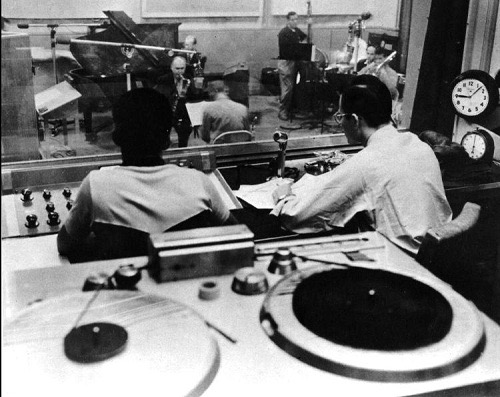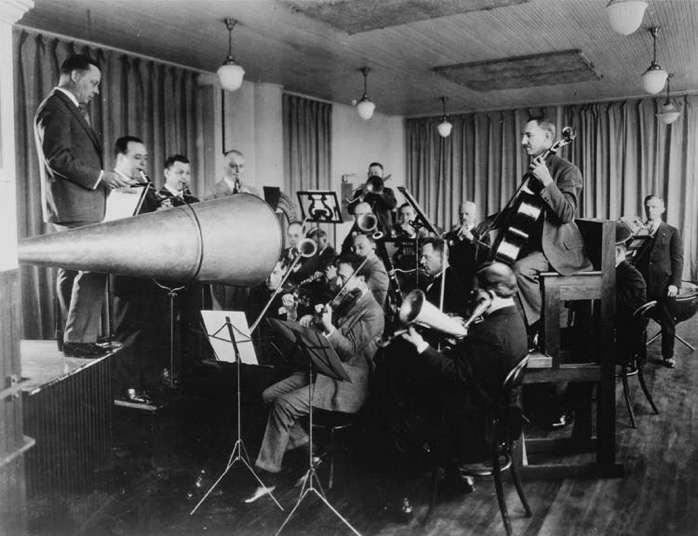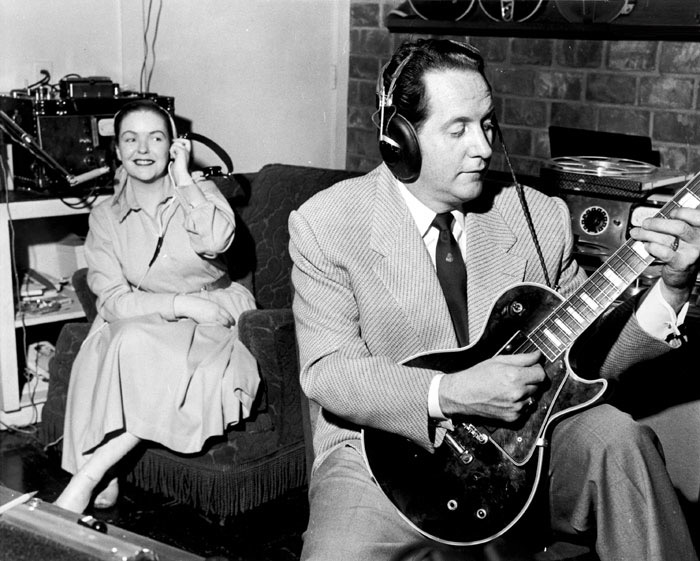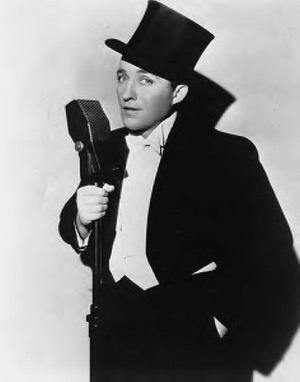
Analog rules!
When Recording Writes the Music
When commercial radio really took off in the 1920's and 30's, it was fueled by advances in recording. You could even say that each drove the other. Early music recordings were mostly documents of what was already being played to live audiences - classical, early jazz, folk, etc. As bands got bigger and louder, the music got more exciting. Dixieland was new, records were all the rage, and radio was just beginning to transport the new sounds across the country, just like the transcontinental railway brought the ideas of the gilded age to America a half-century earlier.
As those songs got louder, instruments such as the guitar got squeezed out. Enter the banjo, an instrument previously associated with steamboats and old west saloons. The banjo's inclusion in Dixieland bands was mostly because it could be heard despite the blaring horns, piano, and drums. When recording one of these bands, each musician would sit around one or more "microphones," which were actually large bells configured to collect the sounds as they cut the record. This was an all-mechanical process, so if the trumpet was too loud, that player would stand further back. And they played LOUD. They had to, the recording technology at the time couldn't record anything subtle.

But the lonely guitar was about to be asked back to the dance. A new kind of music was starting to swing in and take over. The amplified guitar was a backbone of the rhythm section of swing music. There was much experimentation and development during the 1930's and 40's with the electric guitar. Early examples suffered from problems such as feedback, distortion, and uneven sound between strings. But by the early 1950's, the electric guitar as we know it today was taking shape. By the 1960's guitar wizards like Jimmy Hendrix were using distortion and feedback to create new sounds. That's lemonaid from a lemon.
Many credit Les Paul for inventing the electric guitar, but he only perfected what already existed. He did however, use recording technology to forever change the way music is created. It all started with the Nazis. Inside Germany near the end of World War II, Allied troops discovered a previously forgotten technology - reel-to-reel recorders. Initially invented in the early 1900's, it was abandoned because the recording material (magnetized metal ribbon) was too cumbersome to manufacture. The Germans secretly developed and improved it, exploiting its quality and portability to distribute Hitler's speeches to radio stations for synchronized "simulcasting." The Allied countries seized and tranferred many of Germany's technologies, including these recorders, and distributed them among themselves. In America, the Ampex Corporation was the sole manufacturer of reel-to-reel recorders and tape for a time. Les Paul was the recipient of the second model made from friend and Ampex part-owner Bing Crosby. With it, he invented sound-on-sound, the simultaneous playback of a previous recording on one track while mixing it onto a second track while playing a new part. It's similar to what we now know as overdubbing. But in the 1940's, it was an unusual thing to hear the same musician accompanying himself eight times. He also experimented with half-speed recordings, which when played back at normal speed, doubled the pitch and speed, giving a virtuoso effect if done properly.

Paul also owned the first true 8-track recorder capable of selectively choosing different tracks to record onto while playing back previously recorded adjacent ones. However, using multi-track recorders to layer multiple instruments and vocals wouldn't come to prominence until Frank Zappa, the Beatles, and the Beach Boys started pushing its limits in the 1960's. The Beatles' Sergeant Pepper album is probably the best known example of the early experimentation with a reel-to-reel machine to create music: backwards effects, vari-speed recording, tape delay, automatic double tracking, flanging, and other staples of recording today.

The microphone, one of the earliest components of recording (remember, bells were used to vibrate the cutting needle at first), has also influenced music. Early models were offshoots of telephony, but as the technology got better, some artists were using the close miking technique to change the way they sang or played. Bing Crosby, Les Paul, and Mary Ford were early pioneers of the "proximity effect" to make their voices sound richer and fuller. When a sound source, such as a voice, gets very close to a microphone, the bass frequencies are greatly exaggerated. This allows the performer to use less effort, but also gives a more intimate sound. It's hard to imagine a modern recording using any other technique.
There are a multitude of other recording technologies that influence music, but at the root of it all is how musicians adapt, take advantage of, and push technology to create what is in their soul.
Did You Know?
The game of golf may have helped usher in magnetic tape to broadcasting. After the war, Bing Crosby was by now a superstar and wanted nothing more than to travel and play golf, rather than perform live on radio several times a week. The newly formed ABC Radio was interested in building a competitive network, and that meant signing big stars. Their promise to Bing and other performers was to record several performances at one time for later playback. Some even pulled double paychecks by playing bigger-paying gigs on the weekends at the same time the pre-recorded broadcasts were airing.
Tech Notes
Sound-on-sound, invented by Les Paul, is the method of recording on one track, then playing that back while recording new material onto another track. An example using a two-track recorder is:
- Using a mixer, record a drum track onto track 1 only. You now have track 1 with drums, and track 2 silent.
- Rewind the tape and put track 2 into record.
- Bring the output of track 1 into the mixer and raise the level.
- The second instrument, such as bass, is also brought into the mixer.
- Both the output of track 1 and the bass will be recorded onto track 2 at the same time.
- Press record and play the bass along with the pre-recorded drum track from track 1. You now have track 1 with the drums only, and track 2 with drums and bass.
- Rewind the tape and put track 1 into record.
- Bring the output of track 2 (drums and bass) into the mixer and raise the level. Mute the output of track 1.
- The third instrument, such as guitar, is also brought into the mixer.
- Put track 1 into record and unarm track 2. Both the output of track 2 (drums and bass) and the guitar will be recorded onto track 1 at the same time.
- Press record and play the guitar along with the pre-recorded drum and bass track from track 2. You now have track 1 with drums, bass and guitar, and track 2 with drums and bass.
- Repeat as necessary, bouncing tracks back-and-forth.
Pros about this process is that is was a cheap way to have multiple instruments and voices. Cons were many, beginning with the fact that once you recorded over a track, you couldn't get it back. You had to get the balance between the recorded track and the new instrument exactly right early on. You couldn't adjust it later. Also, noise build-up and loss of clarity, known as "generation loss," could become overwhelming if noise-reduction wasn't used. Even then, it was tricky avoiding it. When the Beatles recorded Revolver and Sergeant Pepper, they used a modified version of sound-on-sound by bouncing a stereo submix from a 4-track to tracks 1 and 2 of another 4-track. They would then record 2 new tracks on tracks 3 and 4. Then they would bounce a stereo mix of those 4-tracks back to tracks 1 and 2 of another 4-track. Engineer Geoff Emerick and the other EMI engineers were amazingly able to keep noise low. Because they mostly used fresh tape for each bounce, most of the original tracks remained in archives. George and Giles Martin were able to mine the original tracks for new mixes and realizations for Cirque du Soleil's Love show.
Neil Kesterson







